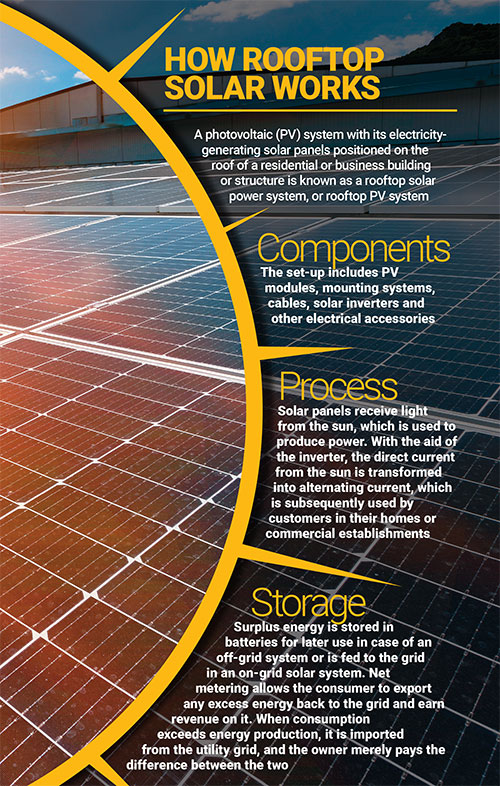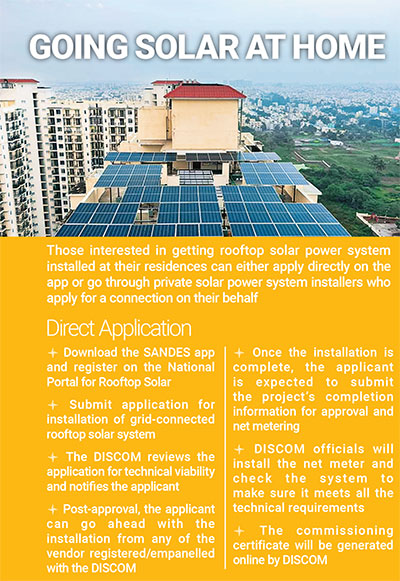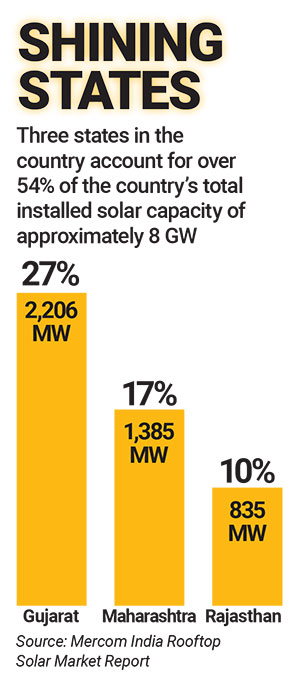Maneesh Chaturvedi, a Bengaluru-based IT professional, lives in a spacious villa with a sprawling terrace. The family of four incurs a monthly electricity bill of Rs 3,000. Yet, unlike many of his neighbours, the idea of getting solar panels installed did not excite him. The investment is too high to make financial sense, he says. Eventually, his neighbours did not go ahead with it either.
Chaturvedi is one of the many who shy away from going the solar way because of the high lumpsum capital investment. “Unless you go with a BESCOM (Bangalore Electricity Supply Company Limited) vendor, the government does not give you a subsidy. Its specified vendors give out old technology-based panels. Also, these panels are interconnected; if one stops working, the others will get affected. Why would I risk Rs 3 lakh to Rs 4 lakh in such a scenario,” the 46-year-old asks.

For a 2,200 square foot house, Chaturvedi will need the rooftop solar system installation with a capacity of up to 4 kW. Though the price and quality of the solar modules and inverters utilised determine the total costs, on an average, a 1 kW rooftop solar system installation could cost between Rs 45,000 and Rs 85,000. If power is to be stored, the expensive batteries would add to the cost.
Not Quite Shining
India, with its geography and demography, has a big role to play in climate action. According to the Ministry of New and Renewable Energy (MNRE), India ranks fourth in solar power capacity. It has pledged to derive 50% share of energy from non-fossil fuels by 2030. Rooftop solar can play a significant role in the story of energy security and net-zero emission goals. However, the segment is nowhere near achieving its full potential.
The country had set itself a 100 GW solar power target by 2022, of which 40 GW was to come from rooftop solar and 60 GW from solar utilities (large-scale power facilities), but it missed the target. According to data shared by consultancy firm JMK Research and Analytics, the solar rooftop capacity by March 31, 2022, was less than 12 GW, of which the residential sub-segment accounted for just 17% (2,010 MW). Rooftop solar installations are more popular in industrial and commercial applications.
While utility-scale solar electricity generation in India has advanced significantly, residential rooftop solar power generation has lagged behind, says Vibhuti Garg, director, South Asia, Institute for Energy Economics and Financial Analysis (IEEFA). “With an average of 300 sunny days each year, India is blessed with an abundance of sunshine. Also, there are more than 300 million households in the country. Rooftop solar installations at residential buildings have enormous potential in India. However, a huge proportion of this potential remains untapped as residential installations in the country aggregate to a mere 2 GW as of FY22,” says the energy economist.
Amplus Solar, a major rooftop solar power plant provider in Asia, has installed solar power systems in more than 1,500 homes with a total capacity of over 11 MW in the last two years in the country. According to the company’s data, residential solar market has steadily grown by 50% year on year, but with the base itself being small, reaching a significant scale seems distant.
Money Saver
High electricity bills prompted retired professor Mukkanti Khagga to switch to solar power. Through solar start-up Freyr Energy, Khagga installed a solar system of 5 kW capacity at his three-bedroom house in Hyderabad in 2021. He spent Rs 2 lakh and availed a subsidy of Rs 50,000 as Freyr is empanelled in several states, including Telangana, as an authorised vendor. Khagga’s electricity bill has come down. However, he is cautious about passing a judgement on its efficacy and viability in the long run. “There are five panels. As of now, there is no maintenance cost, and my electricity bill has reduced. I am happy, but it is too early to say anything,” says Khagga. Rooftop solar power system can either be grid-connected, hybrid or off-grid. Grid-connected solar power systems represent the majority of rooftop PV plants.

Freyr Energy has installed solar power systems at more than 1,000 homes across the country, of which 90% are independent homes. Also, 99% of these are on-grid systems. The company launched its app SunPro+ to help consumers transition from traditional grid power to solar power and tide over challenges like high costs, a lack of financing solutions, limited knowledge and awareness about installation process and maintenance. “In the residential segment, we have doubled our install base compared to last year, and we strongly believe that we will continue to grow exponentially because of our tech approach to customer acquisition and the customer journey. Commercial and industrial component still continues to be a larger part of our business, standing at 70% of our revenues, but we anticipate this to soon become 50/50 in the coming years,” says Radhika Choudary, co-founder of Freyr Energy.
Challenge Upfront
While there are many reasons that contribute to the low adoption of rooftop solar in the residential segment, high upfront costs emerge as one of the key deterrents for homeowners. Gaurav Keswani, associate vice president of rooftop solar solution provider HomeScape by Amplus Solar, observes, “Due to a few government policies, there has been a steep rise in the product costs for solar panels in India, thus increasing the overall cost of home solar installations. To promote growth in rooftop solar installations, the government must ensure the availability of high-efficiency, quality solar modules at competitive prices.”
K.S. Popli got a 6 kW on-grid rooftop solar with 16 panels at his house in Nehru Enclave in Delhi. He spent Rs 4.5 lakh on the system, which got operational in 2020. A retired employee of Indian Renewable Energy Development Agency Limited and now advisor at the International Solar Alliance, Popli says that it was natural for him to choose sustainable lifestyle practices. However, he did not want to go for government-prescribed modules which would have earned him a subsidy. “As I wanted high efficiency, I opted for imported bi-facial modules,” he says. Over the last two years, he has been able to save Rs 80,000 on electricity bills.
Popli feels that he would not have gone for it if he did not have that amount to pay upfront.
Raj Prabhu, CEO of Mercom Capital Group, a clean energy research and communications firm, calls the rising costs a challenge to the goal of increasing rooftop solar capacity. “It is not helping that module costs have increased since April last year after the 40% basic customs duty was introduced on imported modules. Higher borrowing costs and availability of financing can be challenging. Government agencies are reluctant to implement incentives which could lead to loss of revenue for them,” he says. Mercom’s forecast points to a steady increase in the residential segment, but a lot depends on reduction of costs, Prabhu adds.

According to a report by the IEEFA and JMK Research and Analytics, India’s residential rooftop solar capacity has the potential to expand by over 60% by the end of the financial FY23 compared to the previous fiscal year, but experts warn of the roadblocks ahead. Besides the need for high investments, lack of awareness, lack of enough rooftop space and government policies are likely to derail the expected progress.
Aditya Lolla, senior electricity policy analyst for Asia of climate think tank Ember, says, “Difficulty in accessing loans in a highly volatile macro environment, especially in the last two years, made it much more challenging. While some states do offer subsidies, a general lack of awareness and the unavailability of rooftop space among average consumers held back the progress.” Further, terraces have traditionally been used as spaces for household activities like family gatherings, sun-drying edible items, sleeping in summers, etc, he explains, adding that installing solar panels will leave little space for these activities.
Good, Not Good Enough
Under the rooftop solar programme, which encourages the use of small, grid-connected solar photovoltaic (SPV) power plants and rooftop SPV power plants in residential, communal, institutional, industrial and commercial settings, the MNRE offers a 40% subsidy for the first 3 kW and a 20% subsidy for each additional 3 kW up to 10 kW through local electricity distribution companies (DISCOMs) in the states.
In 2022, the government developed the National Portal for Rooftop Solar to formalise a direct benefit transfer system and facilitate residential rooftop solar installations. In December 2022, the MNRE announced its decision to extend the rooftop solar programme till March 2026 from the existing deadline of December 2022. When asked if the idea was to increase the numbers, Lalit Bohra, joint secretary, MNRE, justified the move saying, “The rooftop solar programme will keep on extending. It has a lot of potential and is picking up. Projects like NREGA continue over time. The budget is used up in some time, but it is reallocated over a period of time.”
However, it is not easy to avail these subsidies due to regressive government policies, feels Kartikeya Khanna, secretary, Westend Heights Apartment Complex, Begur, Bengaluru. The apartment complex with 1,830 flats has a rooftop solar system with an installed capacity of 285 kW and intends to take it up to 600 kW in the future. All common area facilities including street lights, common area lights, 50+ lifts, pumping stations, etc., are powered by solar energy.
“The empanelment of inverter manufacturers and models, restrictions for apartment complexes regarding net metering and high import duties on solar modules and panels are regressive policies. They contribute to a lower adoption of solar rooftop photovoltaic system in the residential sector,” says Khanna. As per the BESCOM policy, applicants can use inverters only from its empanelled firms for the solar power system to be connected to its grid.
Despite the positive projections, the adoption of rooftop solar in the residential segment is sluggish.
The Mercom India Rooftop Solar Market Report notes that Gujarat was at the top of the list of states in terms of cumulative rooftop solar installations up to 2022, with 2,206 MW of the country’s total installed rooftop solar capacity of approximately 8,077 MW, followed by Maharashtra with 1,385 MW and Rajasthan 835 MW. “Gujarat’s SURYA scheme, under which 1.1 GW capacity was installed in the state in the last 18 months, is a shining example for other regional markets to emulate. It showcased how proactive support from state agencies, streamlining of relevant procedures and effective implementation of incentives to end consumers can lead to the successful adoption of rooftop solar,” says Garg.
Given the land availability constraint, decentralised renewable energy, especially rooftop solar, can play a significant role in helping India meet its emission reduction targets. The commercial viability of battery storage will also influence the deployment of solar rooftops. Government push has and will continue to be the major driver for this segment.











